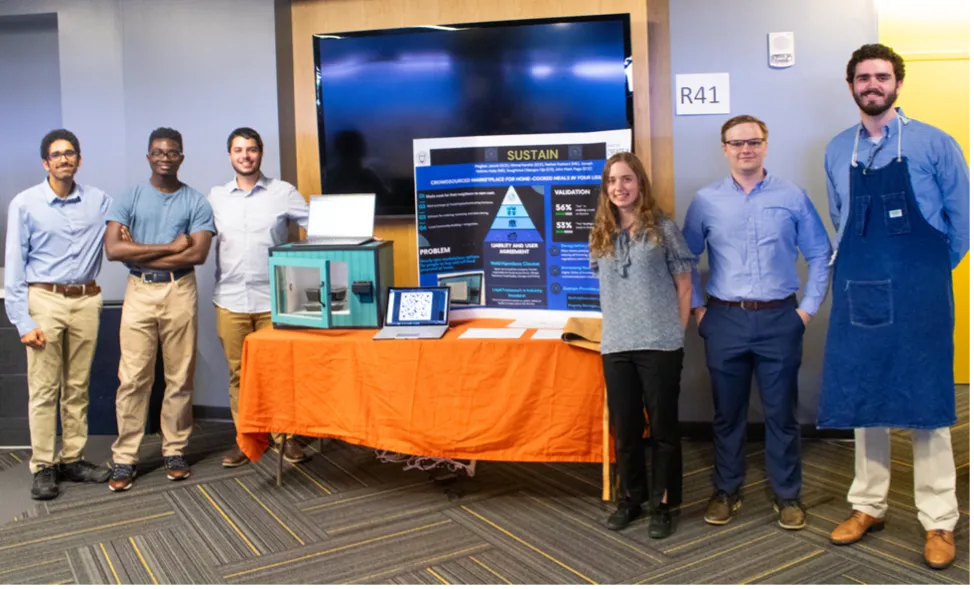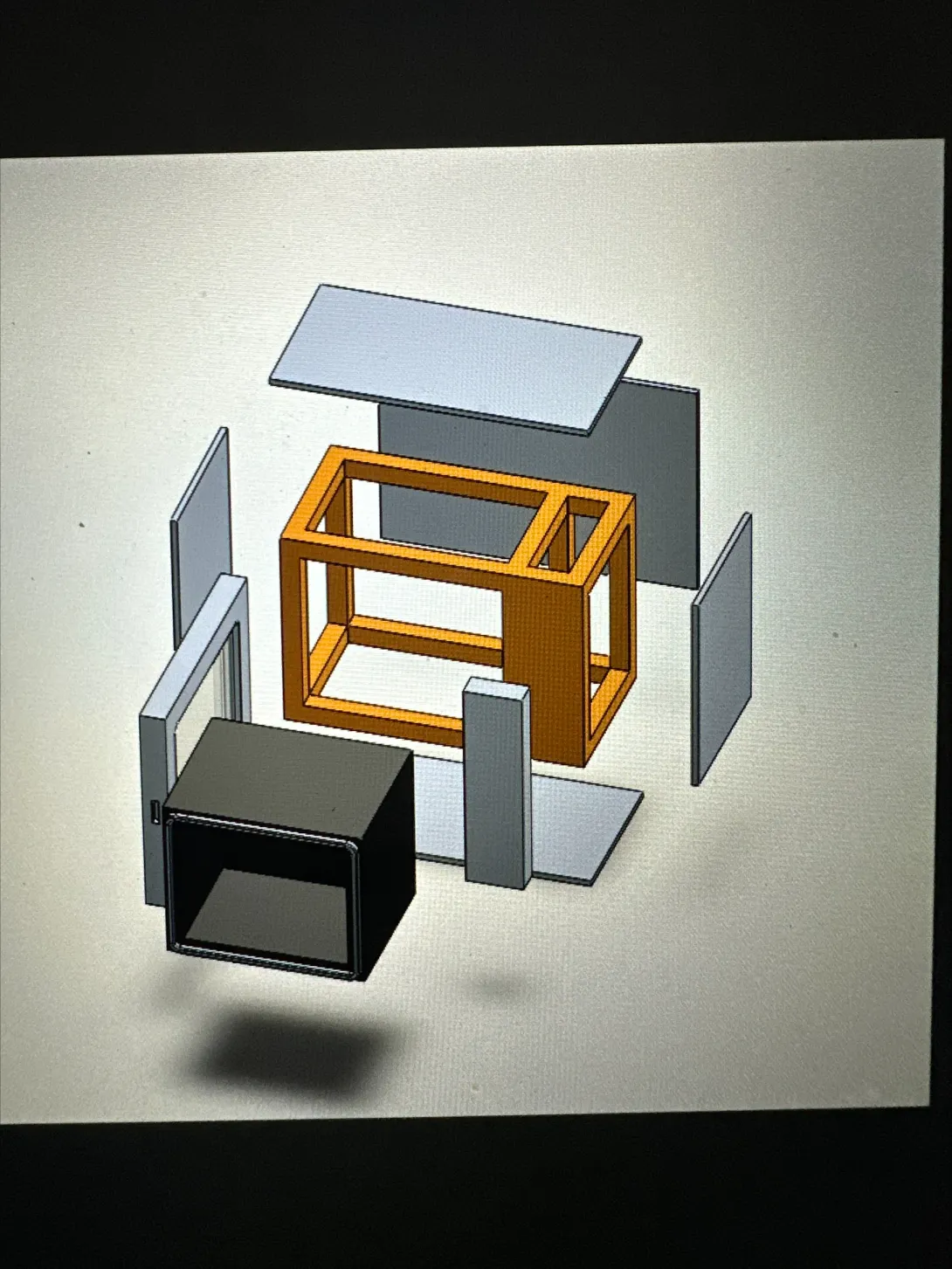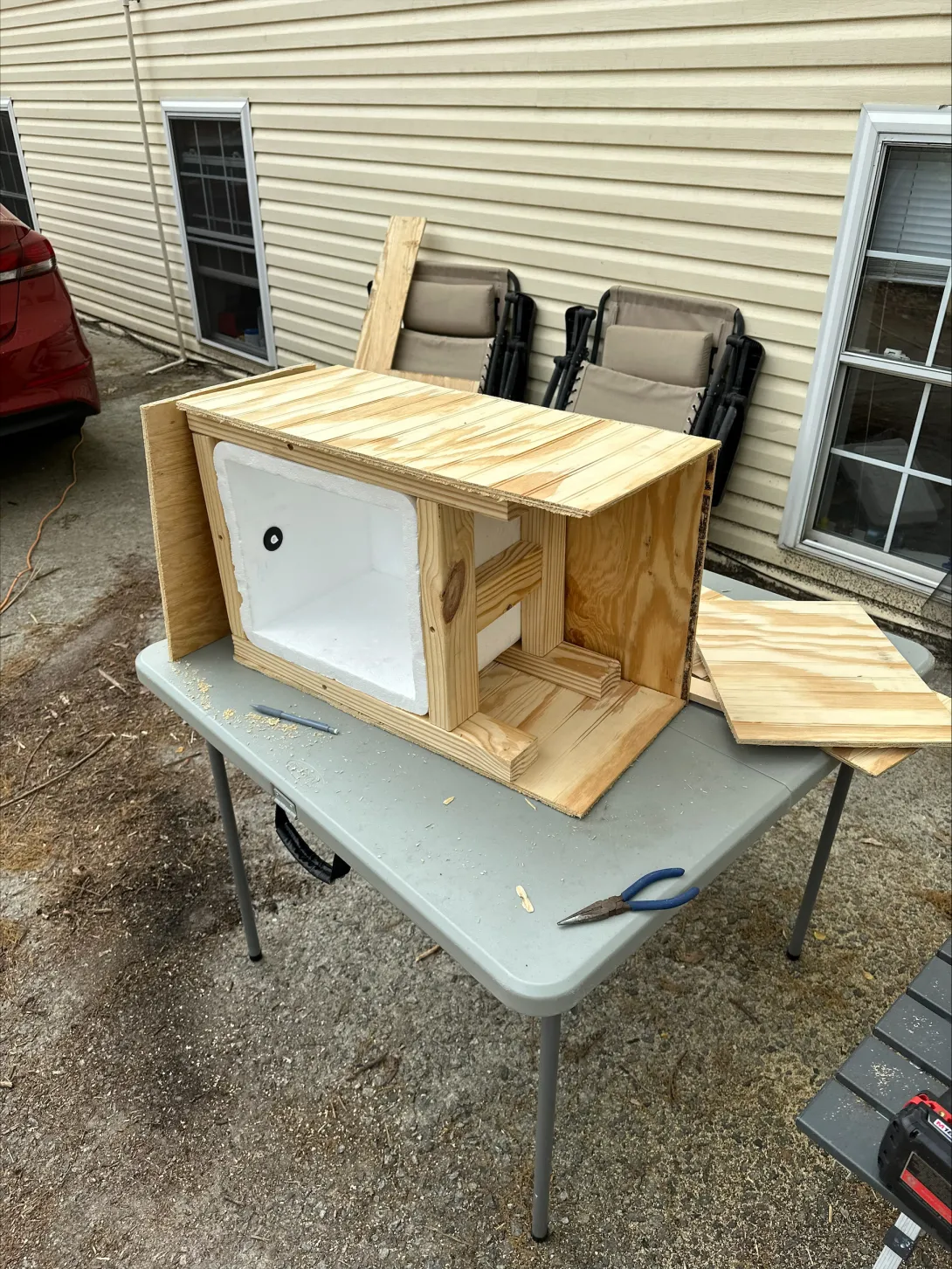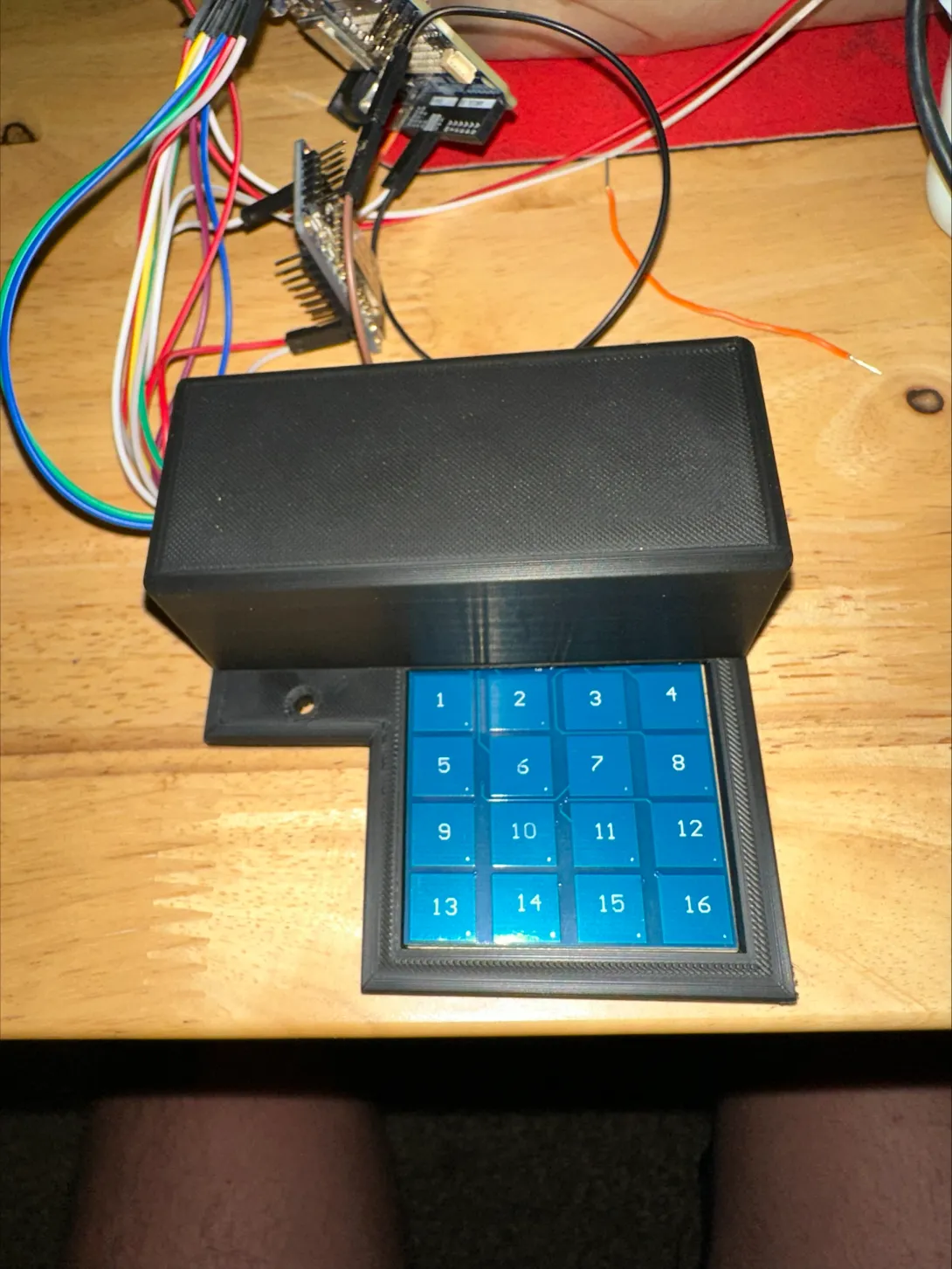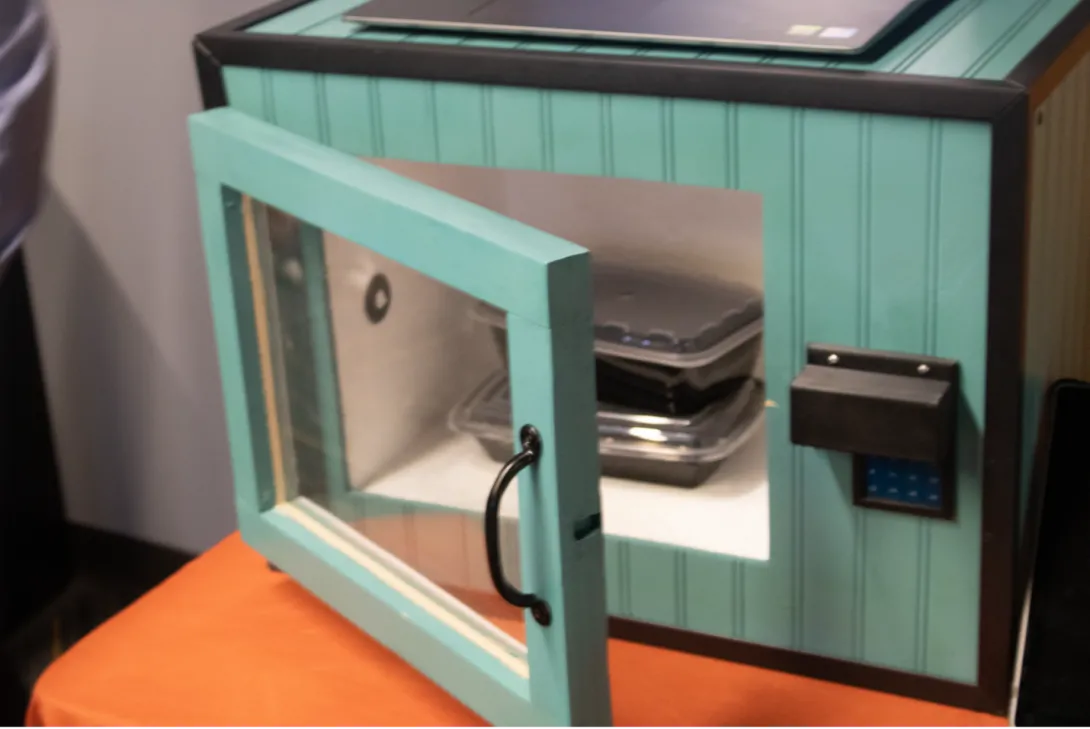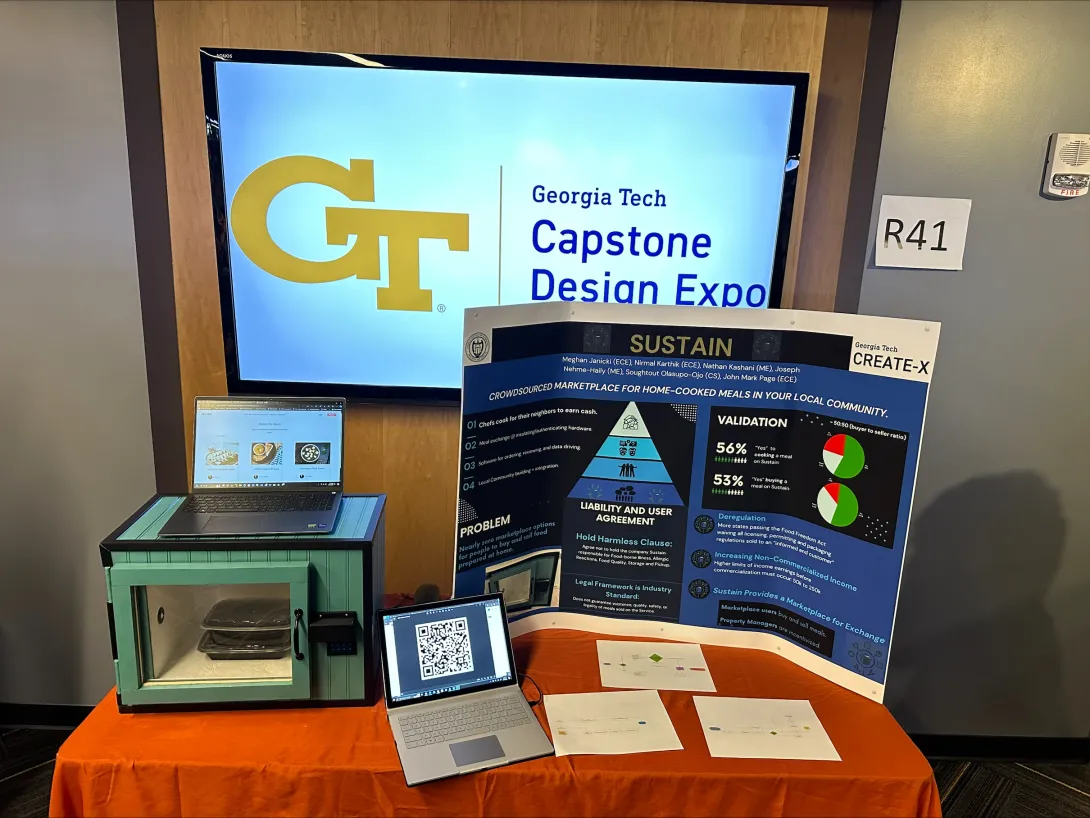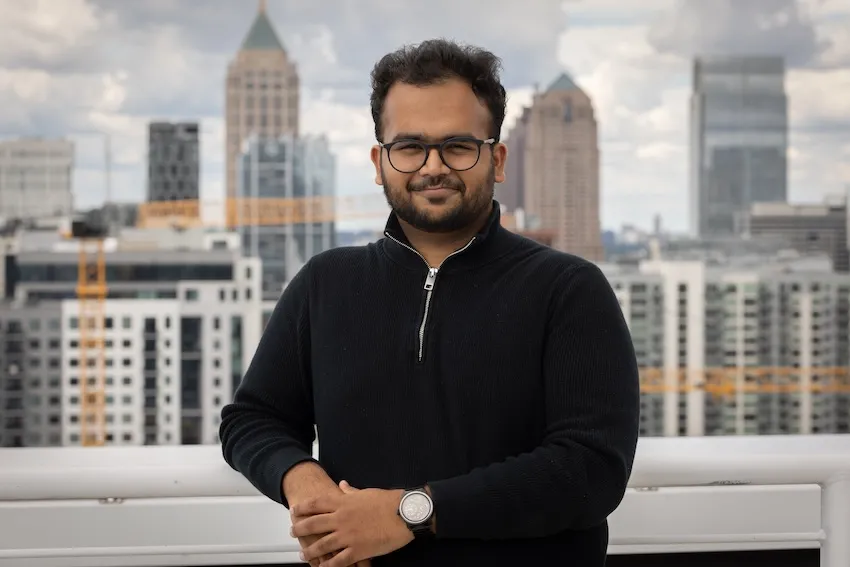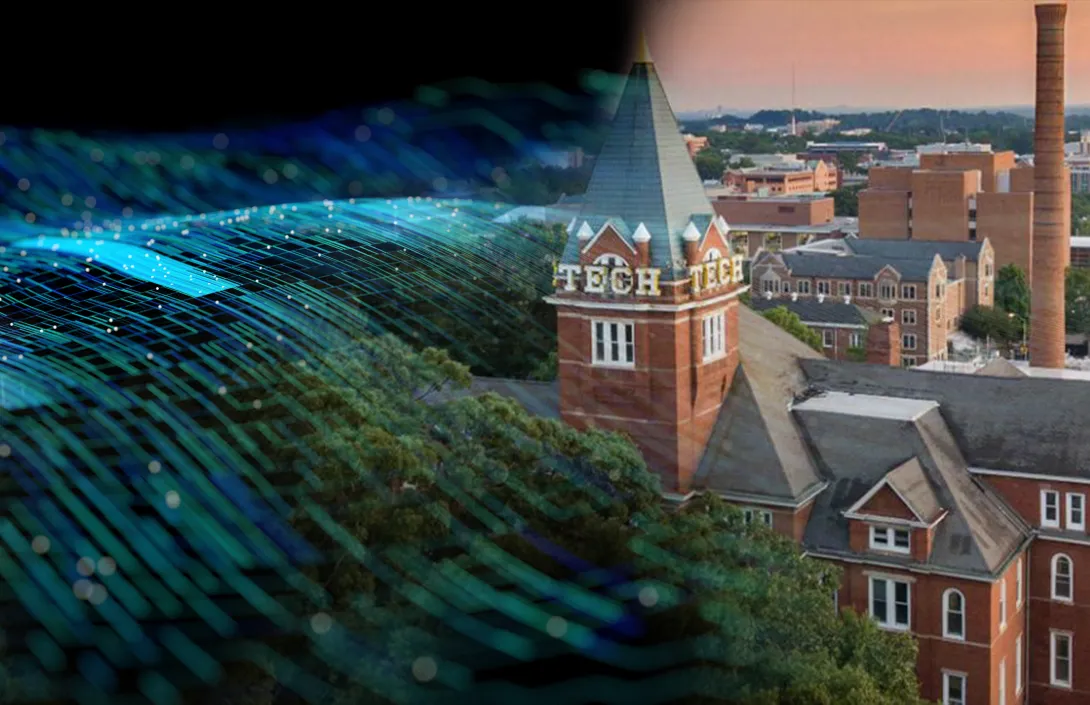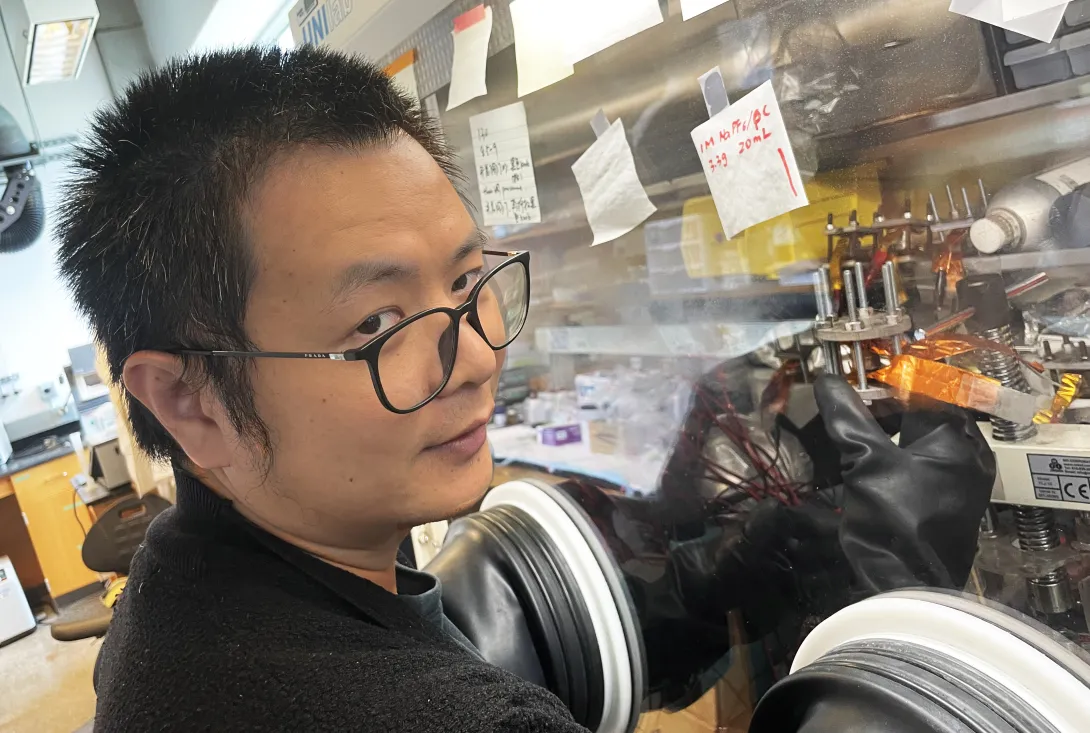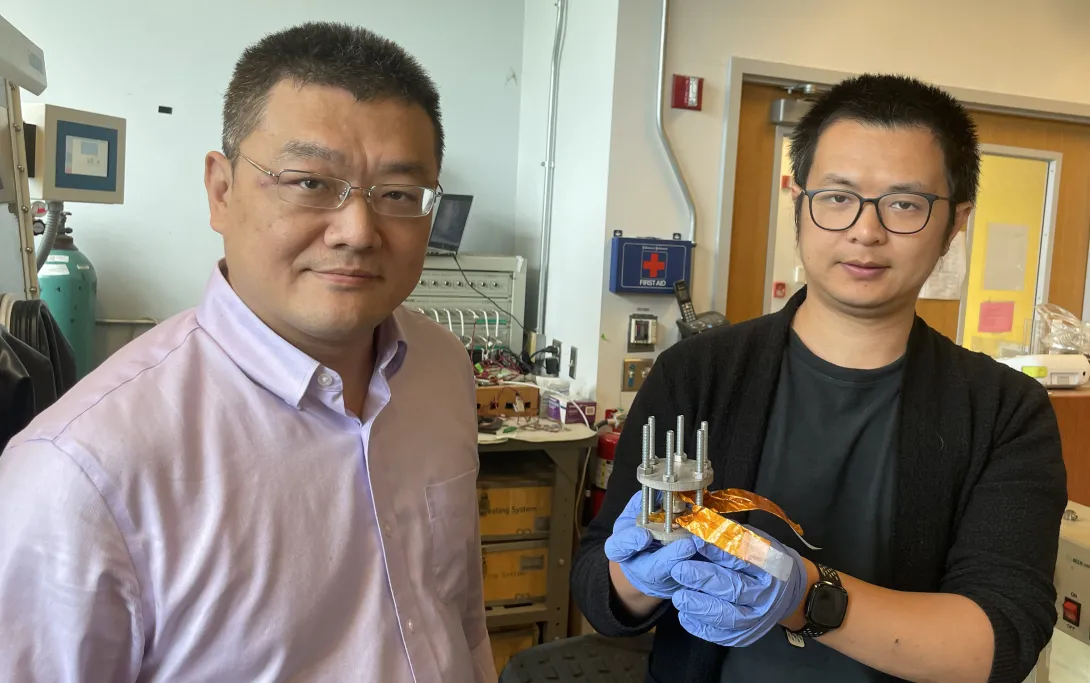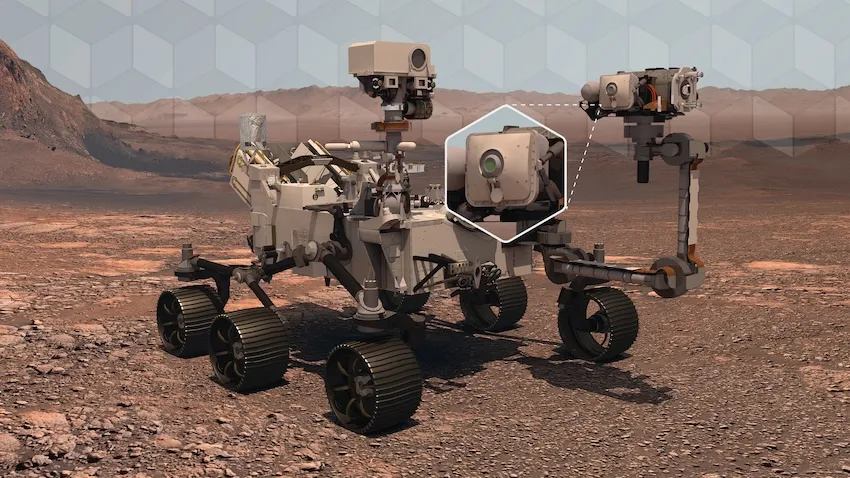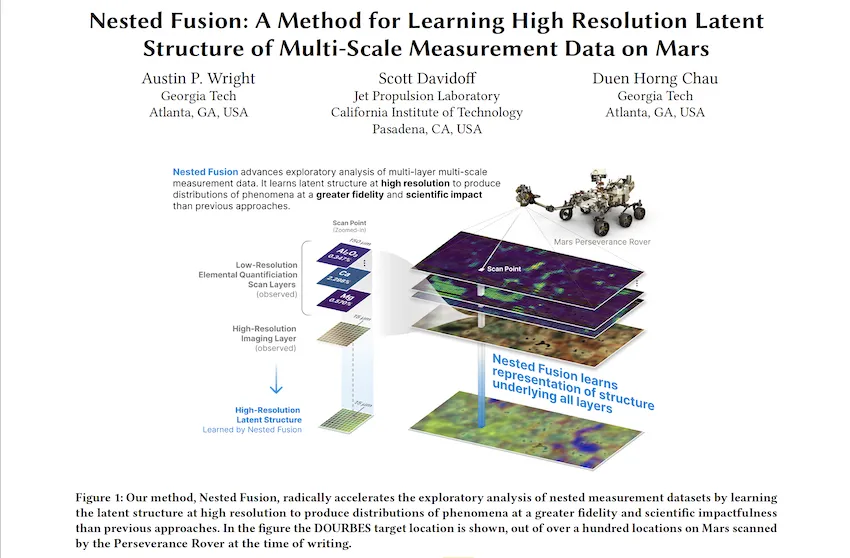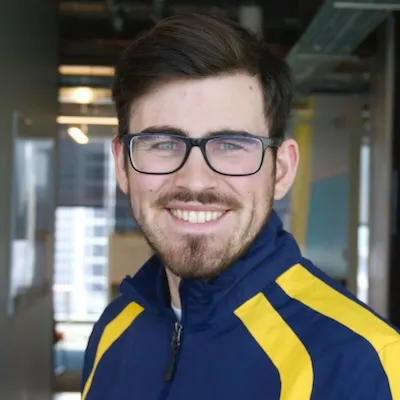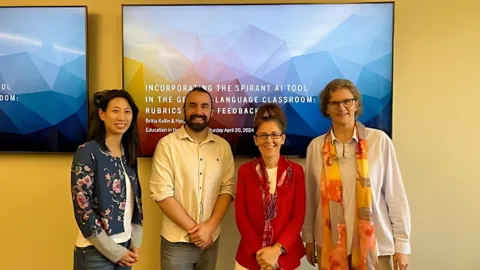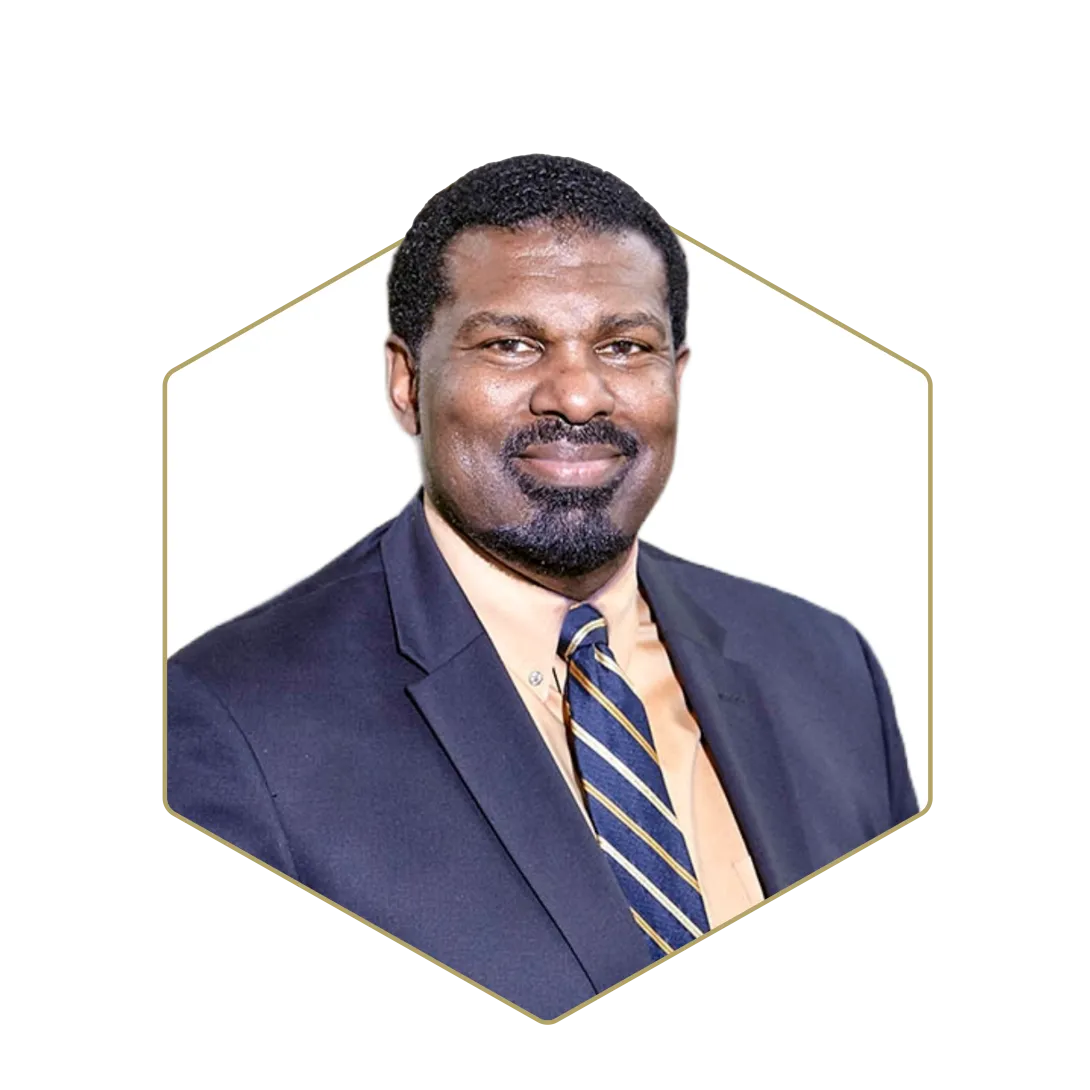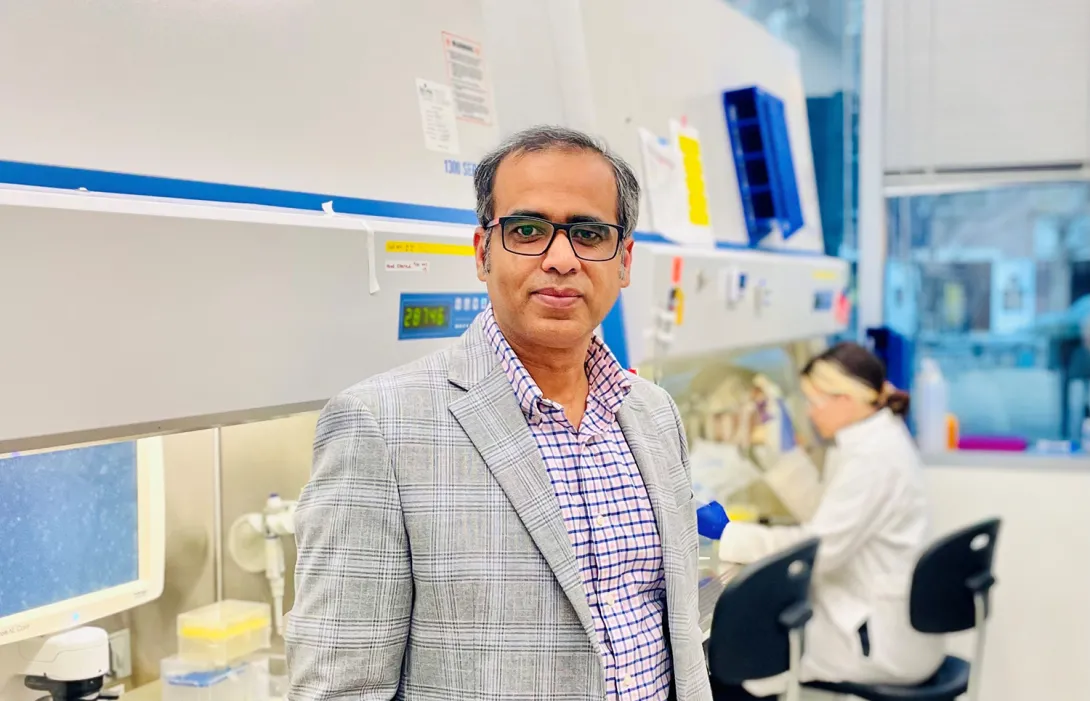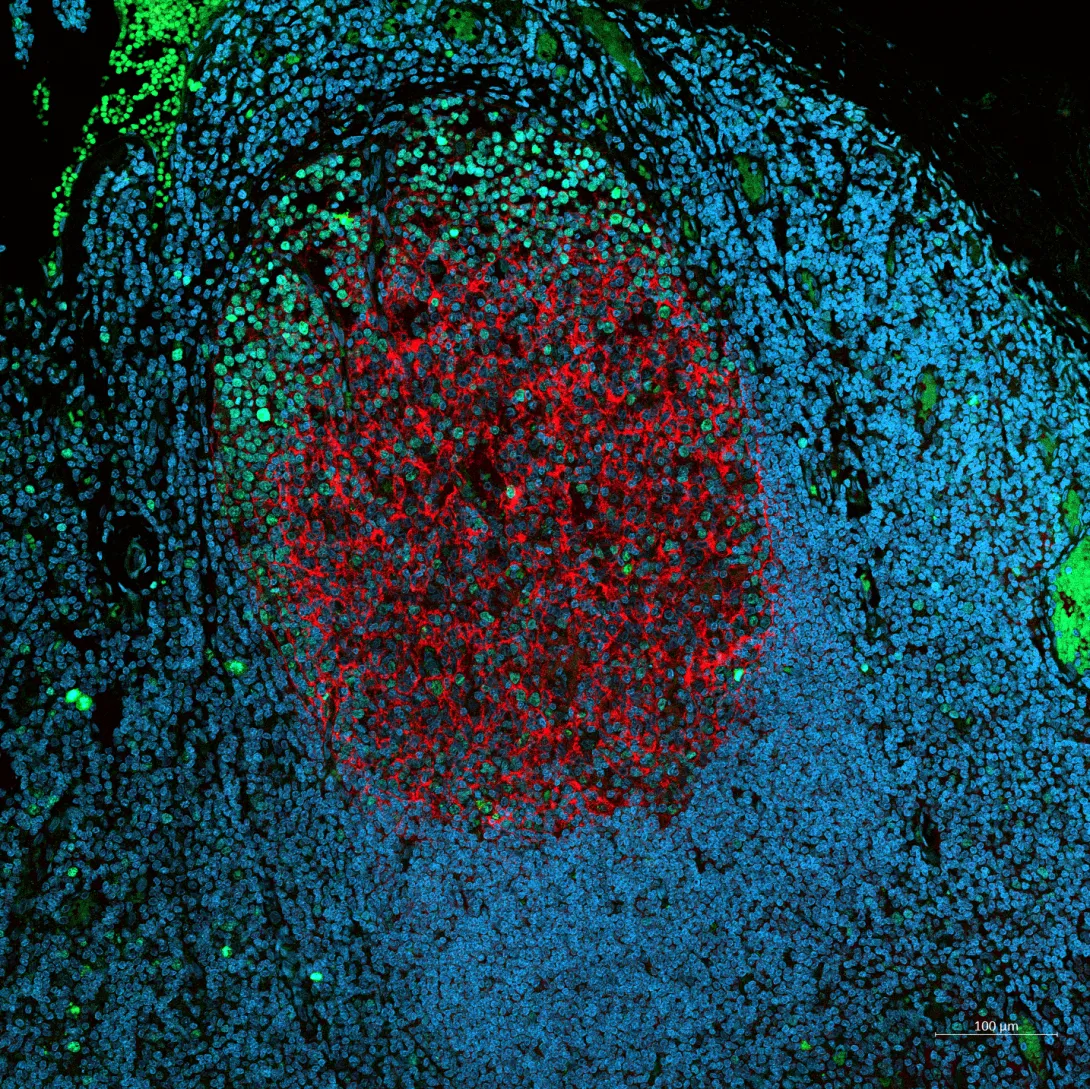Sep. 30, 2024
CREATE-X Capstone Design offers students a unique opportunity to blend their technical skills with entrepreneurial ambitions. In this interdisciplinary program, teams of students identify real-world problems and develop innovative solutions through customer discovery and hands-on experience. Below we spotlight Team Sustain, a group of students who participated in the Spring 2024 Capstone Expo. Their project focused on bringing convenience to home-cooked meals, showcasing the practical application of their engineering and entrepreneurial skills. Read on to learn about their journey, their challenges, and how you can get involved in CREATE-X Capstone Design.
Team Sustain
Sustain offers a way to crowdsource meals and provide home cooks with a cash incentive. The system includes software for ordering, reviewing, and collecting data and hardware for meal exchange.
Nirmal Karthik, electrical and computer engineering
Soughtout Olasupo-Ojo, computer science
Nathan Kashani, mechanical engineering
Meghan Janicki, electrical and computer engineering
Joseph Nehme-Haily, mechanical engineering
John Mark Page, electrical engineering
Why did you all choose this project?
“One of the main things CREATE-X Capstone encourages us to do is customer discovery. Through our discussions, we realized that many people enjoy home-cooked meals but find them inconvenient to prepare. While most things in life are just a click away, home-cooked meals still require a personal touch. CREATE-X challenged us to find a problem and create a solution, so we focused on making home-cooked meals more convenient,” Page said.
Why CREATE-X Capstone?
“After graduation, I wanted to try my hand at entrepreneurship later. I thought CREATE-X was a good way for me to try and learn entrepreneurship skills: how to run a business, what it looks like, the timeline, and so on. Either way, if it went well or badly, I could say with my heart that I have an idea of how to do entrepreneurship,” Olasupo-Ojo said.
“You can go into a big city like Atlanta and actually feel like you can do something to help people. It is a great benefit, as opposed to being in the technical weeds of an engineering project. Mixing them together has been a great experience,” Janicki said.
“CREATE-X empowers students to think independently and explore projects they’re passionate about. We get to drive our projects and businesses, learning skills firsthand rather than just in theory,” Kashani said.
What was your biggest struggle?
“As engineers, we’re classically, especially in school, already given the problem. So, the challenge was figuring out what the problem was, and if our solution really solves the root cause of the problem. We figured out how to find the problem,” Page said.
“Figuring out the idea was our biggest struggle. We delved into markets to find opportunities and ways to help people,” Kashani said.
What has been your favorite part of this experience?
“The team. Make sure you surround yourself with good people, and I think each of us has done that. That’s what I’m proudest about — our team,” Page said.
What advice would you give to someone considering entrepreneurship?
“Develop the skill sets to see problems and be able to think about them. At the beginning of the semester, we were thinking about solar design and building solar design for farms, and now we are in a completely different space. But we’re still applying the same skills and building something up from it that matters. The most important skill is adaptability,” Janicki said.
“Be ready to make mistakes. You won’t get it right the first, second, or even third time. Customer discovery is a continuous process — don’t let setbacks discourage you,” Olasupo-Ojo said.
“Don’t be afraid to get started. If you’re feeling nervous or unsure, there’s only one way to find out, so I’d say go full force into it,” Kashani said.
CREATE-X Capstone Design is open to senior undergraduate students in mechanical engineering, electrical and computer engineering, industrial and systems engineering, and computer science. Course registration is available for the fall and spring semesters, and the current sections are ME4723-X/X01, CS4723-X/X01, ECE4853 X/LX, BME4723-X/X01, and ISYE4106.
CREATE-X also offers other programs like Startup Lab and Idea to Prototype, providing students with a foundational entrepreneurial education. For those interested in launching their own ventures, CREATE-X’s 12-week summer accelerator, Startup Launch, offers mentorship, $5,000 in seed funding, and $150,000 of in-kind services. The priority deadline for the accelerator is Nov. 17. Apply for Startup Launch to maximize your chances of acceptance and receive early feedback.
Making Sustain: The Gallery
News Contact
Breanna Durham
Marketing Strategist
Sep. 26, 2024
Is it a building or a street? How tall is the building? Are there powerlines nearby?
These are details autonomous flying vehicles would need to know to function safely. However, few aerial image datasets exist that can adequately train the computer vision algorithms that would pilot these vehicles.
That’s why Georgia Tech researchers created a new benchmark dataset of computer-generated aerial images.
Judy Hoffman, an assistant professor in Georgia Tech’s School of Interactive Computing, worked with students in her lab to create SKYSCENES. The dataset contains over 33,000 aerial images of cities curated from a computer simulation program.
Hoffman said sufficient training datasets could unlock the potential of autonomous flying vehicles. Constructing those datasets is a challenge the computer vision research community has been working for years to overcome.
“You can’t crowdsource it the same way you would standard internet images,” Hoffman said. “Trying to collect it manually would be very slow and expensive — akin to what the self-driving industry is doing driving around vehicles, but now you’re talking about drones flying around.
“We must fix those problems to have models that work reliably and safely for flying vehicles.”
Many existing datasets aren’t annotated well enough for algorithms to distinguish objects in the image. For example, the algorithms may not recognize the surface of a building from the surface of a street.
Working with Hoffman, Ph.D. student Sahil Khose tried a new approach — constructing a synthetic image data set from a ground-view, open-source simulator known as CARLA.
CARLA was originally designed to provide ground-view simulation for self-driving vehicles. It creates an open-world virtual reality that allows users to drive around in computer-generated cities.
Khose and his collaborators adjusted CARLA’s interface to support aerial views that mimic views one might get from unmanned aerial vehicles (UAVs).
What's the Forecast?
The team also created new virtual scenarios to mimic the real world by accounting for changes in weather, times of day, various altitudes, and population per city. The algorithms will struggle to recognize the objects in the frame consistently unless those details are incorporated into the training data.
“CARLA’s flexibility offers a wide range of environmental configurations, and we take several important considerations into account while curating SKYSCENES images from CARLA,” Khose said. “Those include strategies for obtaining diverse synthetic data, embedding real-world irregularities, avoiding correlated images, addressing skewed class representations, and reproducing precise viewpoints.”
SKYSCENES is not the largest dataset of aerial images to be released, but a paper co-authored by Khose shows that it performs better than existing models.
Khose said models trained on this dataset exhibit strong generalization to real-world scenarios, and integration with real-world data enhances their performance. The dataset also controls variability, which is essential to perform various tasks.
“This dataset drives advancements in multi-view learning, domain adaptation, and multimodal approaches, with major implications for applications like urban planning, disaster response, and autonomous drone navigation,” Khose said. “We hope to bridge the gap for synthetic-to-real adaptation and generalization for aerial images.”
Seeing the Whole Picture
For algorithms, generalization is the ability to perform tasks based on new data that expands beyond the specific examples on which they were trained.
“If you have 200 images, and you train a model on those images, they’ll do well at recognizing what you want them to recognize in that closed-world initial setting,” Hoffman said. “But if we were to take aerial vehicles and fly them around cities at various times of the day or in other weather conditions, they would start to fail.”
That’s why Khose designed algorithms to enhance the quality of the curated images.
“These images are captured from 100 meters above ground, which means the objects appear small and are challenging to recognize,” he said. “We focused on developing algorithms specifically designed to address this.”
Those algorithms elevate the ability of ML models to recognize small objects, improving their performance in navigating new environments.
“Our annotations help the models capture a more comprehensive understanding of the entire scene — where the roads are, where the buildings are, and know they are buildings and not just an obstacle in the way,” Hoffman said. “It gives a richer set of information when planning a flight.
“To work safely, many autonomous flight plans might require a map given to them beforehand. If you have successful vision systems that understand exactly what the obstacles in the real world are, you could navigate in previously unseen environments.”
For more information about Georgia Tech Research at ECCV 2024, click here.
News Contact
Nathan Deen
Communications Officer
School of Interactive Computing
Sep. 24, 2024
A year ago, Ray Hung, a master’s student in computer science, assisted Professor Thad Starner in constructing an artificial intelligence (AI)-powered anti-plagiarism tool for Starner’s 900-student Intro to Artificial Intelligence (CS3600) course.
While the tool proved effective, Hung began considering ways to deter plagiarism and improve the education system.
Plagiarism can be prevalent in online exams, so Hung looked at oral examinations commonly used in European education systems and rooted in the Socratic method.
One of the advantages of oral assessments is they naturally hinder cheating. Consulting ChatGPT wouldn’t benefit a student unless the student memorizes the entire answer. Even then, follow-up questions would reveal a lack of genuine understanding.
Hung drew inspiration from the 2009 reboot of Star Trek, particularly the opening scene in which a young Spock provides oral answers to questions prompted by AI.
“I think we can do something similar,” Hung said. “Research has shown that oral assessment improves people’s material understanding, critical thinking, and communication skills.
“The problem is that it’s not scalable with human teachers. A professor may have 600 students. Even with teaching assistants, it’s not practical to conduct oral assessments. But with AI, it’s now possible.”
Hung developed The Socratic Mind with Starner, Scheller College of Business Assistant Professor Eunhee Sohn, and researchers from the Georgia Tech Center for 21st Century Universities (C21U).
The Socratic Mind is a scalable, AI-powered oral assessment platform leveraging Socratic questioning to challenge students to explain, justify, and defend their answers to showcase their understanding.
“We believe that if you truly understand something, you should be able to explain it,” Hung said.
“There is a deeper need for fostering genuine understanding and cultivating high-order thinking skills. I wanted to promote an education paradigm in which critical thinking, material understanding, and communication skills play integral roles and are at the forefront of our education.”
Hung entered his project into the Learning Engineering Tools Competition, one of the largest education technology competitions in the world. Hung and his collaborators were among five teams that won a Catalyst Award and received a $50,000 prize.
Benefits for Students
The Socratic Mind will be piloted in several classes this semester with about 2,000 students participating. One of those classes is the Intro to Computing (CS1301) class taught by College of Computing Professor David Joyner.
Hung said The Socratic Mind will be a resource students can use to prepare to defend their dissertation or to teach a class if they choose to pursue a Ph.D. Anyone struggling with public speaking or preparing for job interviews will find the tool helpful.
“Many users are interested in AI roleplay to practice real-world conversations,” he said. “The AI can roleplay a manager if you want to discuss a promotion. It can roleplay as an interviewer if you have a job interview. There are a lot of uses for oral assessment platforms where you can practice talking with an AI.
“I hope this tool helps students find their education more valuable and help them become better citizens, workers, entrepreneurs, or whoever they want to be in the future.”
Hung said the chatbot is not only conversational but also adverse to human persuasion because it follows the Socratic method of asking follow-up questions.
“ChatGPT and most other large language models are trained as helpful, harmless assistants,” he said. “If you argue with it and hold your position strong enough, you can coerce it to agree. We don’t want that.
“The Socratic Mind AI will follow up with you in real-time about what you just said, so it’s not a one-way conversation. It’s interactive and engaging and mimics human communication well.”
Educational Overhaul
C21U Director of Research in Education Innovation Jonna Lee and C21U Research Scientist Meryem Soylu will measure The Socratic Mind’s effectiveness during the pilot and determine its scalability.
“I thought it would be interesting to develop this further from a learning engineering perspective because it’s about systematic problem solving, and we want to create scalable solutions with technologies,” Lee said.
“I hope we can find actionable insights about how this AI tool can help transform classroom learning and assessment practices compared to traditional methods. We see the potential for personalized learning for various student populations, including non-traditional lifetime learners."
Hung said The Socratic Mind has the potential to revolutionize the U.S. education system depending on how the system chooses to incorporate AI.
Recognizing the advancement of AI is likely an unstoppable trend. Hung advocates leveraging AI to enhance learning and unlock human potential rather than focusing on restrictions.
“We are in an era in which information is abundant, but wisdom is scarce,” Hung said. “Shallow and rapid interactions drive social media, for example. We think it’s a golden time to elevate people’s critical thinking and communication skills.”
For more information about The Socratic Mind and to try a demo, visit the project's website.
News Contact
Nathan Deen
Communications Officer
School of interactive Computing
Sep. 24, 2024
In a major step forward for deploying artificial intelligence (AI) in industry, Georgia Tech’s newly established AI hub, Tech AI, has partnered with the Center for Scientific Software Engineering (CSSE). This collaboration aims to bridge the gap between academia and industry by advancing scalable AI solutions in sectors such as energy, mobility, supply chains, healthcare, and services.
Building on the Foundation of Success
CSSE, founded in late 2021 and supported by Schmidt Sciences as part of their VISS initiative, was created to advance and support scientific research by applying modern software engineering practices, cutting-edge technologies, and modern tools to the development of scientific software within and outside Georgia Tech. CSSE is led by Alex Orso, professor and associate dean in the College of Computing, and Jeff Young, a principal scientist at Georgia Tech. The Center's team boasts over 60 years of combined experience, with engineers from companies such as Microsoft, Amazon, and various startups, working under the supervision of the Center’s Head of Engineering, Dave Brownell. Their focus is on turning cutting-edge research into real-world products.
“Software engineering is about much more than just writing code,” Orso explained. “It’s also about specifying, designing, testing, deploying, and maintaining these systems.”
A Partnership to Support AI Research and Innovation
Through this collaboration, CSSE’s expertise will be integrated into Tech AI to create a software engineering division that can support AI engineering and also create new career opportunities for students and researchers.
Pascal Van Hentenryck, the A. Russell Chandler III Chair and professor in the H. Milton Stewart School of Industrial Engineering (ISyE) and director of both the NSF AI Research Institute for Advances in Optimization (AI4OPT) and Tech AI, highlighted the potential of this partnership.
“We are impressed with the technology and talent within CSSE,” Van Hentenryck said. “This partnership allows us to leverage an existing, highly skilled engineering team rather than building one from scratch. It’s a unique opportunity to build the engineering pillar of Tech AI and push our AI initiatives forward, moving from pilots to products.”
“Joining our forces and having a professional engineering resource within Tech AI will give Georgia Tech a great competitive advantage over other AI initiatives,” Orso added.
One of the first projects under this collaboration focuses on AI in energy, particularly in developing new-generation, AI-driven, market clearing optimization and real-time risk assessment. Plans are also in place to pursue several additional projects, including the creation of an AI-powered search engine assistant, demonstrating the center’s ability to tackle complex, real-world problems.
This partnership is positioned to make a significant impact on applied AI research and innovation at Georgia Tech. By integrating modern software engineering practices, the collaboration will address key challenges in AI deployment, scalability, and sustainability, and translate AI research innovations into products with real societal impact.
“This is a match made in heaven,” Orso noted, reflecting on the collaboration’s alignment with Georgia Tech’s strategic goals to advance technology and improve human lives. Van Hentenryck added that “the collaboration is as much about creating new technologies as it is about educating the next generation of engineers.”
Promoting Open Source at Tech AI
A crucial element supporting the new Tech AI and CSSE venture is Georgia Tech’s Open Source Program Office (OSPO), a joint effort with the College of Computing, PACE, and the Georgia Tech Library. As an important hub of open-source knowledge, OSPO will provide education, training, and guidance on best practices for using and contributing to open-source AI frameworks.
“A large majority of the software driving our current accomplishments in AI research and development is built on a long history of open-source software and data sets, including frameworks like PyTorch and models like Meta’s LLaMA,” said Jeff Young, principal investigator at OSPO. “Understanding how we can best use and contribute to open-source AI is critical to our future success with Tech AI, and OSPO is well-suited to provide guidance, training, and expertise around these open-source tools, frameworks, and pipelines.”
Looking Ahead
As the partnership between Tech AI and CSSE evolves, both groups anticipate a future in which interdisciplinary research drives innovation. By integrating AI with real-world software engineering, the collaboration promises to create new opportunities for students, researchers, and Georgia Tech as a whole.
With a strong foundation, a talented team, and a clear vision, Tech AI and CSSE together are set to break new ground in AI and scientific research, propelling Georgia Tech to the forefront of technological advancement in the AI field.
About the Center for Scientific Software Engineering (CSSE)
The CSSE at Georgia Tech, supported by an $11 million grant from Schmidt Sciences, is one of four scientific software engineering centers within the Virtual Institute for Scientific Software (VISS). Its mission is to develop scalable, reliable, open-source software for scientific research, ensuring maintainability and effectiveness. Learn more at https://ssecenter.cc.gatech.edu.
About Georgia Tech’s Open Source Program Office (OSPO)
Georgia Tech’s OSPO supports the development of open-source research software across campus. Funded by a Sloan Foundation grant, OSPO provides community guidelines, training, and outreach to promote a thriving open-source ecosystem. Learn more at https://ospo.cc.gatech.edu.
About Schmidt Sciences
Schmidt Sciences is a nonprofit organization founded in 2024 by Eric and Wendy Schmidt that works to advance science and technology that deepens human understanding of the natural world and develops solutions to global issues. The organization makes grants in four areas—AI and advanced computing, astrophysics and space, biosciences and climate—as well as supporting researchers in a variety of disciplines through its science systems program. Learn more at https://www.schmidtsciences.org/.
About Tech AI
Tech AI is Georgia Tech’s AI hub, advancing AI through research, education, and responsible deployment. The hub focuses on AI solutions for real-world applications, preparing the next generation of AI leaders. Learn more at https://ai.gatech.edu.
News Contact
Breon Martin
AI Marketing Communications Manager
Sep. 22, 2024
A multi-institutional research team led by Georgia Tech’s Hailong Chen has developed a new, low-cost cathode that could radically improve lithium-ion batteries (LIBs) — potentially transforming the electric vehicle (EV) market and large-scale energy storage systems.
“For a long time, people have been looking for a lower-cost, more sustainable alternative to existing cathode materials. I think we’ve got one,” said Chen, an associate professor with appointments in the George W. Woodruff School of Mechanical Engineering and the School of Materials Science and Engineering.
The revolutionary material, iron chloride (FeCl3), costs a mere 1-2% of typical cathode materials and canstore the same amount of electricity. Cathode materials affect capacity, energy, and efficiency, playing a major role in a battery’s performance, lifespan, and affordability.
“Our cathode can be a game-changer,” said Chen, whose team describes its work in Nature Sustainability. “It would greatly improve the EV market — and the whole lithium-ion battery market.”
First commercialized by Sony in the early 1990s, LIBs sparked an explosion in personal electronics, like smartphones and tablets. The technology eventually advanced to fuel electric vehicles, providing a reliable, rechargeable, high-density energy source. But unlike personal electronics, large-scale energy users like EVs are especially sensitive to the cost of LIBs.
Batteries are currently responsible for about 50% of an EV’s total cost, which makes these clean-energy cars more expensive than their internal combustion, greenhouse-gas-spewing cousins. The Chen team’s invention could change that.
Building a Better Battery
Compared to old-fashioned alkaline and lead-acid batteries, LIBs store more energy in a smaller package and power a device longer between charges. But LIBs contain expensive metals, including semiprecious elements like cobalt and nickel, and they have a high manufacturing cost.
So far, only four types of cathodes have been successfully commercialized for LIBs. Chen’s would be the fifth, and it would represent a big step forward in battery technology: the development of an all-solid-state LIB.
Conventional LIBs use liquid electrolytes to transport lithium ions for storing and releasing energy. They have hard limits on how much energy can be stored, and they can leak and catch fire. But all-solid-state LIBs use solid electrolytes, dramatically boosting a battery’s efficiency and reliability and making it safer and capable of holding more energy. These batteries, still in the development and testing phase, would be a considerable improvement.
As researchers and manufacturers across the planet race to make all-solid-state technology practical, Chen and his collaborators have developed an affordable and sustainable solution. With the FeCl3 cathode, a solid electrolyte, and a lithium metal anode, the cost of their whole battery system is 30-40% of current LIBs.
“This could not only make EVs much cheaper than internal combustion cars, but it provides a new and promising form of large-scale energy storage, enhancing the resilience of the electrical grid,” Chen said. “In addition, our cathode would greatly improve the sustainability and supply chain stability of the EV market.”
Solid Start to New Discovery
Chen’s interest in FeCl3 as a cathode material originated with his lab’s research into solid electrolyte materials. Starting in 2019, his lab tried to make solid-state batteries using chloride-based solid electrolyteswith traditional commercial oxide-based cathodes. It didn’t go well — the cathode and electrolyte materials didn’t get along.
The researchers thought a chloride-based cathode could provide a better pairing with the chloride electrolyte to offer better battery performance.
“We found a candidate (FeCl3) worth trying, as its crystal structure is potentially suitable for storing and transporting Li ions, and fortunately, it functioned as we expected,” said Chen.
Currently, the most popularly used cathodes in EVs are oxides and require a gigantic amount of costly nickel and cobalt, heavy elements that can be toxic and pose an environmental challenge. In contrast, the Chen team’s cathode contains only iron (Fe) and chlorine (Cl)—abundant, affordable, widely used elements found in steel and table salt.
In their initial tests, FeCl3 was found to perform as well as or better than the other, much more expensive cathodes. For example, it has a higher operational voltage than the popularly used cathode LiFePO4 (lithium iron phosphate, or LFP), which is the electrical force a battery provides when connected to a device, similar to water pressure from a garden hose.
This technology may be less than five years from commercial viability in EVs. For now, the team will continue investigating FeCl3 and related materials, according to Chen. The work was led by Chen and postdoc Zhantao Liu (the lead author of the study). Collaborators included researchers from Georgia Tech’s Woodruff School (Ting Zhu) and the School of Earth and Atmospheric Sciences (Yuanzhi Tang), as well as the Oak Ridge National Laboratory (Jue Liu) and the University of Houston (Shuo Chen).
“We want to make the materials as perfect as possible in the lab and understand the underlying functioning mechanisms,” Chen said. “But we are open to opportunities to scale up the technology and push it toward commercial applications.”
CITATION: Zhantao Liu, Jue Liu, Simin Zhao, Sangni Xun, Paul Byaruhanga, Shuo Chen, Yuanzhi Tang, Ting Zhu, Hailong Chen. “Low-cost iron trichloride cathode for all-solid-state lithium-ion batteries.” Nature Sustainability.
FUNDING: National Science Foundation (Grant Nos. 1706723 and 2108688)
News Contact
Sep. 19, 2024
A new algorithm tested on NASA’s Perseverance Rover on Mars may lead to better forecasting of hurricanes, wildfires, and other extreme weather events that impact millions globally.
Georgia Tech Ph.D. student Austin P. Wright is first author of a paper that introduces Nested Fusion. The new algorithm improves scientists’ ability to search for past signs of life on the Martian surface.
In addition to supporting NASA’s Mars 2020 mission, scientists from other fields working with large, overlapping datasets can use Nested Fusion’s methods toward their studies.
Wright presented Nested Fusion at the 2024 International Conference on Knowledge Discovery and Data Mining (KDD 2024) where it was a runner-up for the best paper award. KDD is widely considered the world's most prestigious conference for knowledge discovery and data mining research.
“Nested Fusion is really useful for researchers in many different domains, not just NASA scientists,” said Wright. “The method visualizes complex datasets that can be difficult to get an overall view of during the initial exploratory stages of analysis.”
Nested Fusion combines datasets with different resolutions to produce a single, high-resolution visual distribution. Using this method, NASA scientists can more easily analyze multiple datasets from various sources at the same time. This can lead to faster studies of Mars’ surface composition to find clues of previous life.
The algorithm demonstrates how data science impacts traditional scientific fields like chemistry, biology, and geology.
Even further, Wright is developing Nested Fusion applications to model shifting climate patterns, plant and animal life, and other concepts in the earth sciences. The same method can combine overlapping datasets from satellite imagery, biomarkers, and climate data.
“Users have extended Nested Fusion and similar algorithms toward earth science contexts, which we have received very positive feedback,” said Wright, who studies machine learning (ML) at Georgia Tech.
“Cross-correlational analysis takes a long time to do and is not done in the initial stages of research when patterns appear and form new hypotheses. Nested Fusion enables people to discover these patterns much earlier.”
Wright is the data science and ML lead for PIXLISE, the software that NASA JPL scientists use to study data from the Mars Perseverance Rover.
Perseverance uses its Planetary Instrument for X-ray Lithochemistry (PIXL) to collect data on mineral composition of Mars’ surface. PIXL’s two main tools that accomplish this are its X-ray Fluorescence (XRF) Spectrometer and Multi-Context Camera (MCC).
When PIXL scans a target area, it creates two co-aligned datasets from the components. XRF collects a sample's fine-scale elemental composition. MCC produces images of a sample to gather visual and physical details like size and shape.
A single XRF spectrum corresponds to approximately 100 MCC imaging pixels for every scan point. Each tool’s unique resolution makes mapping between overlapping data layers challenging. However, Wright and his collaborators designed Nested Fusion to overcome this hurdle.
In addition to progressing data science, Nested Fusion improves NASA scientists' workflow. Using the method, a single scientist can form an initial estimate of a sample’s mineral composition in a matter of hours. Before Nested Fusion, the same task required days of collaboration between teams of experts on each different instrument.
“I think one of the biggest lessons I have taken from this work is that it is valuable to always ground my ML and data science problems in actual, concrete use cases of our collaborators,” Wright said.
“I learn from collaborators what parts of data analysis are important to them and the challenges they face. By understanding these issues, we can discover new ways of formalizing and framing problems in data science.”
Wright presented Nested Fusion at KDD 2024, held Aug. 25-29 in Barcelona, Spain. KDD is an official special interest group of the Association for Computing Machinery. The conference is one of the world’s leading forums for knowledge discovery and data mining research.
Nested Fusion won runner-up for the best paper in the applied data science track, which comprised of over 150 papers. Hundreds of other papers were presented at the conference’s research track, workshops, and tutorials.
Wright’s mentors, Scott Davidoff and Polo Chau, co-authored the Nested Fusion paper. Davidoff is a principal research scientist at the NASA Jet Propulsion Laboratory. Chau is a professor at the Georgia Tech School of Computational Science and Engineering (CSE).
“I was extremely happy that this work was recognized with the best paper runner-up award,” Wright said. “This kind of applied work can sometimes be hard to find the right academic home, so finding communities that appreciate this work is very encouraging.”
News Contact
Bryant Wine, Communications Officer
bryant.wine@cc.gatech.edu
Sep. 19, 2024
Georgia Tech alum Tucker von Holten, who mastered Spanish in high school and minored in German at the Institute, was surprised when his mother struggled to understand basic Spanish after more than a year of playing Duolingo.
So, the 2020 computer science graduate asked his former German professors in the School of Modern Languages if they would take part in the ideation and pilot of a new language learning technology — one that would support classroom language instruction, rather than trying to take its place.
“Language acquisition goes far beyond vocabulary and grammar,” said Associate Professor of German Britta Kallin. “We want students to experience the culture lived through the language.”
Von Holten agreed, and so he got to work, founding the educational technology company Spirant AI. Over the next year, he stayed in contact with Kallin and other faculty members while creating the Spirant Assistant, a language learning tool suite that harnesses the strengths of generative artificial intelligence (AI) to support language students and instructors.
“With the Spirant Assistant, we wanted to provide students with more robust tools for language learning,” said von Holten. “We also wanted to create a ‘digital teaching assistant’ for language instructors, who rarely have the luxury of TAs in their classrooms.”
The Initial Pilot of the Spirant Assistant
In Spring 2024, the Spirant Assistant was ready for its first classroom pilot — and the School of Modern Languages was up to the challenge. Kallin and her colleague, Assistant Professor of German Hyoun-A Joo, used the Spirant Assistant in their upper-level German classes at Georgia Tech.
Kallin and Joo collected feedback from students and consulted with von Holten to share what was going well and suggest ways the assistant could be refined.
“Tucker is uniquely qualified to create a language instruction tool. This project is informed by his experience as an alum, as someone with computer expertise, and as a person who knows what it’s like to excel in learning a language,” said Kallin.
Kallin said that her students and Hyoun-A Joo’s found the spring class experience a positive one.
“Students in our spring classes liked the writing and reading tools a lot, as well as the feedback and suggestions they got from the Spirant Assistant,” said Kallin. “We suggested a few adjustments, and Tucker has implemented those for the fall.”
Kallin and John Lyon, professor, school chair, and Charles Smithgall Jr. Institute Chair in the School of Modern Languages, are piloting an updated version of the Spirant Assistant in their advanced German classes this semester.
“Any new tool creates a new way of learning for our students and new ways of teaching for instructors,” said Kallin. “We’re learning how to implement the Spirant Assistant in ways that best support our students and the course design. It will be great to see how it evolves, and how our teaching might make progress as we use it more.”
What Does the Spirant Assistant Do?
When building the Spirant Assistant, von Holten and his team consulted with Modern Languages faculty about their needs. The result is a suite of different tools for instructors and students, all of which leverage the power of generative AI.
The Assistant’s primary tool is “First Pass,” an AI first-draft support function that reviews a student essay, applies the instructor’s rubric such as grammar, suggests corrections in English or in the target language, and suggests a grade, which the instructor can either approve or change.
“We were surprised to learn that instructors spend about half of their time grading,” said von Holten. “We wanted to create something that would help with that process.”
Von Holten is sensitive to potential concerns about the accuracy of a virtual AI grading assistant and emphasizes that First Pass is meant only to support the process of grading, not replace it. Instead, he likens the role of generative AI in the classroom to that of the calculator.
“The calculator fundamentally changed the way we teach and learn mathematics. Like the calculator, AI isn’t capable of human insight, reflection, or understanding. It’s a tool.”
The Spirant Assistant also offers support for students, including an AI reading tool and a “storyteller” function that creates stories in the language students are learning. Another of its capabilities is tailoring any given piece of writing to the student’s reading level, making authentic or literary texts more easily understandable for students.
“Instructors or students can use the storyteller to create a story that illustrates a set of vocabulary words, or that repeatedly uses a grammatical concept such as passive voice or subjunctive,” said von Holten.
“Most language learners have had the experience of trying to read text in a new language with three or four reference books open on the side — a dictionary, a verb conjugator, and a grammar reference,” he said. “So, we built the Spirant Assistant so that an instructor can input the text they want students to read, and the Assistant makes all of this reference information clickable, right in the text.”
What’s Next for the Spirant Assistant?
In its current iteration, the Spirant Assistant supports language learning and instruction in German and Spanish, with plans to expand its capabilities — and its influence — on the horizon.
“We’re very proud of our partnership with Georgia Tech. We’re dedicated to enhancing language education nationwide,” said von Holten. “We look forward to working with more universities to bring the Spirant Assistant’s transformative suite of tools to classrooms across the country.”
The School of Modern Languages is a unit of the Ivan Allen College of Liberal Arts.
To find out more about Georgia Tech’s policy on the responsible adoption and use of AI tools, you can visit the Office of Information Technology’s Artificial Intelligence page.
News Contact
Stephanie N. Kadel
Ivan Allen College of Liberal Arts
Sep. 18, 2024
A Georgia Institute of Technology faculty member was recently honored for his efforts connecting new supply chain technologies with rural and underserved communities across Georgia.
Charles Easley Jr., a professor in the Georgia Institute of Technology’s Supply Chain and Logistics Institute (SCL) and project lead for the Rural Supply Chain Resilience initiative through Georgia Artificial Intelligence in Manufacturing (Georgia AIM), received a Building Better Regions Superstar Award during a special event in Wichita, Kansas, marking two years of the Build Back Better federal grant program. Georgia AIM is among the recipients of a Build Back Better grant.
Read the full story here.
Sep. 18, 2024
The National Institutes of Health (NIH) has awarded $7.5 million to Ankur Singh, Carl Ring Family Professor in the George W. Woodruff School of Mechanical Engineering (ME) and professor in the Wallace H. Coulter Department of Biomedical Engineering (BME) at Georgia Tech and Emory, for his pioneering research in creating functional models of the human immune system in the lab.
The funding, sourced from the National Institute of Allergy and Infectious Diseases, supports two projects aimed at developing human immune organoids, which are sophisticated models engineered to replicate and study the natural human immune responses. The research could revolutionize vaccine development and immune system research, particularly for aging populations.
"Little advancement has been made in this area due to the complex nature of the immune system and the challenges of making a functional human immune tissue outside the body,” said Singh, who is also director of the Center for Immunoengineering at Georgia Tech. “I am grateful to the NIH for supporting our work, which will enable us to develop an advanced technology that can help solve the problems of emerging infections and enhance our timely response to them.”
Building Next-Generation Human Immune Organoids
The goal of Singh’s first project is to replicate the complex environment of germinal centers (GCs) — the sites within lymph nodes where B cells are trained to produce the antibodies crucial for fighting infections. While animal models and current engineered systems have offered insights, they fall short in recreating the intricate processes that occur in human GCs, which limits their utility in vaccine development and understanding immune responses.
Singh’s method involves using a hydrated polymer-based gel material to create a structure that mimics the environment of lymphoid tissue in the body. By adding human immune cells (like B cells, T cells, and support cells) into this gel, the project tries to recreate how B cells mature into specialized immune cells that are important for a strong and lasting immune response. This advancement will allow scientists to grow and study these cells in the lab and use them for better vaccine testing, therapeutic development including cell-based therapies, and to deepen our understanding of the immune system.
The second project addresses a pressing issue in public health: the decline in immune function with age. As people age, their ability to mount effective immune responses against new infections diminishes, leading to higher mortality rates from diseases such as influenza and Covid-19. However, the underlying mechanisms — whether due to defects in aged B cells, impaired T cells, or changes in the lymphoid tissue environment — remain poorly understood.
Singh’s research proposes the development of an “aged B cell follicle” organoid, a novel platform that replicates the lymphoid microenvironment of older individuals. This system will allow researchers to dissect the factors driving age-related declines in immune function, offering a new tool for studying how aged B cells respond to antigens and identifying molecular targets to rejuvenate immune responses.
A Pioneering Step Forward in Immunology Research
The broader impact of Singh’s organoid research is wide-ranging. By enabling the study of human immune responses in a controlled, reproducible environment, the organoids could dramatically accelerate the development of vaccines and immunotherapies. The models could also provide new insights into whether a particular vaccine will be effective for a given individual, potentially reducing the time and cost of clinical trials.
Singh’s aged immune organoid platform could serve as a rapid screening tool for identifying older individuals who are likely to respond poorly to vaccines, enabling more personalized and effective vaccination strategies for that population. The models could be particularly useful in the context of pandemics or seasonal flu outbreaks, where timely and effective immunization is critical.
“By securing this substantial NIH funding, Singh’s work is poised to make a significant impact on both the scientific community and public health,” said Andrés García, executive director of the Parker H. Petit Institute for Bioengineering and Bioscience, Regents' Professor in ME, the Petit Director's Chair in Bioengineering and Bioscience, and a collaborator on Singh’s first project. “This innovative immunoengineering research not only promises to advance our understanding of immune system function and aging, but also holds the potential to transform vaccine development, offering new hope for more effective disease prevention strategies across the lifespan.”
The NIH’s investment in Singh’s research underscores a growing recognition of the need for innovative approaches to studying human immunity. The Food and Drug Administration Modernization Act 2.0, for example, promotes the use of organs-on-chip technologies in the service of drug development. As organoid technologies continue to evolve, they could come to represent the future of immunological research, providing powerful new tools to combat infectious diseases and improve health outcomes globally.
"Reflecting on the pandemic, we relied on years of research to develop vaccines and understand immune responses,” Singh said. “This new technology will allow us to innovate more rapidly and take bold steps toward creating an immune system outside the body.”
---
Key collaborators on the first project include Andrés García; Ahmet Coskun, the Bernie-Marcus Early-Career Professor in BME; and Dr. Ignacio Sanz, Mason I. Lowance Professor of Medicine and Pediatrics and chief of the chief of the Division of Rheumatology at Emory School of Medicine.
Key collaborators on the second project include Coskun; Jeremy Boss, professor and chair of the Department of Microbiology and Immunology at Emory School of Medicine; and Ranjan Sen, senior investigator in the Laboratory of Molecular Biology and Immunology at NIH’s National Institute on Aging.
Sep. 16, 2024
Michael Fonseca presented the inaugural ‘Systems Matter’ seminar hosted by the Institute for Matter and Systems on Tuesday, September 10.
“We are privileged to have Mike here to share his wealth of knowledge and insights from his extensive experience in both the academic and corporate sectors of the medical device industry,” said Michael Filler, Deputy Director of IMS.
Fonseca’s talk, titled “Using the Inertia of Matter and MEMS Systems to Measure and Diagnose Complex Cardiovascular and Pulmonary Diseases”, focused on the development of systems that combine sensors and navigation systems to monitor and manage complex diseases.
Fonseca is no stranger to Georgia Tech. He received his B.S. in Electrical Engineering and during his Ph.D. he worked with Mark Allen and the late Oliver Brand on MEMS research.
The Systems Matter Seminar Series brings experts in the areas of materials, devices, and processes together twice a month to share innovative research in those areas. Learn more about the series and view the full list of speakers here.
